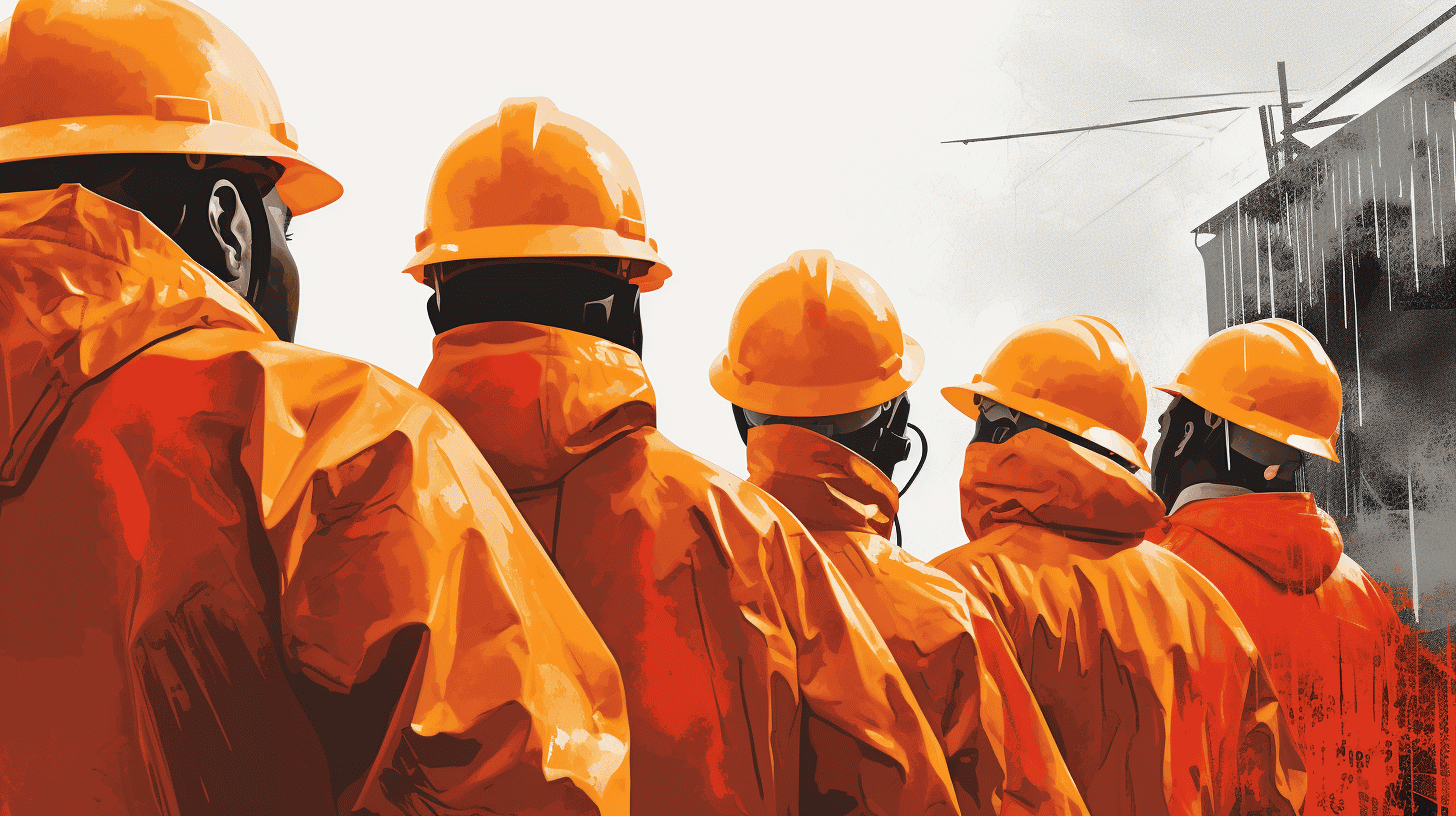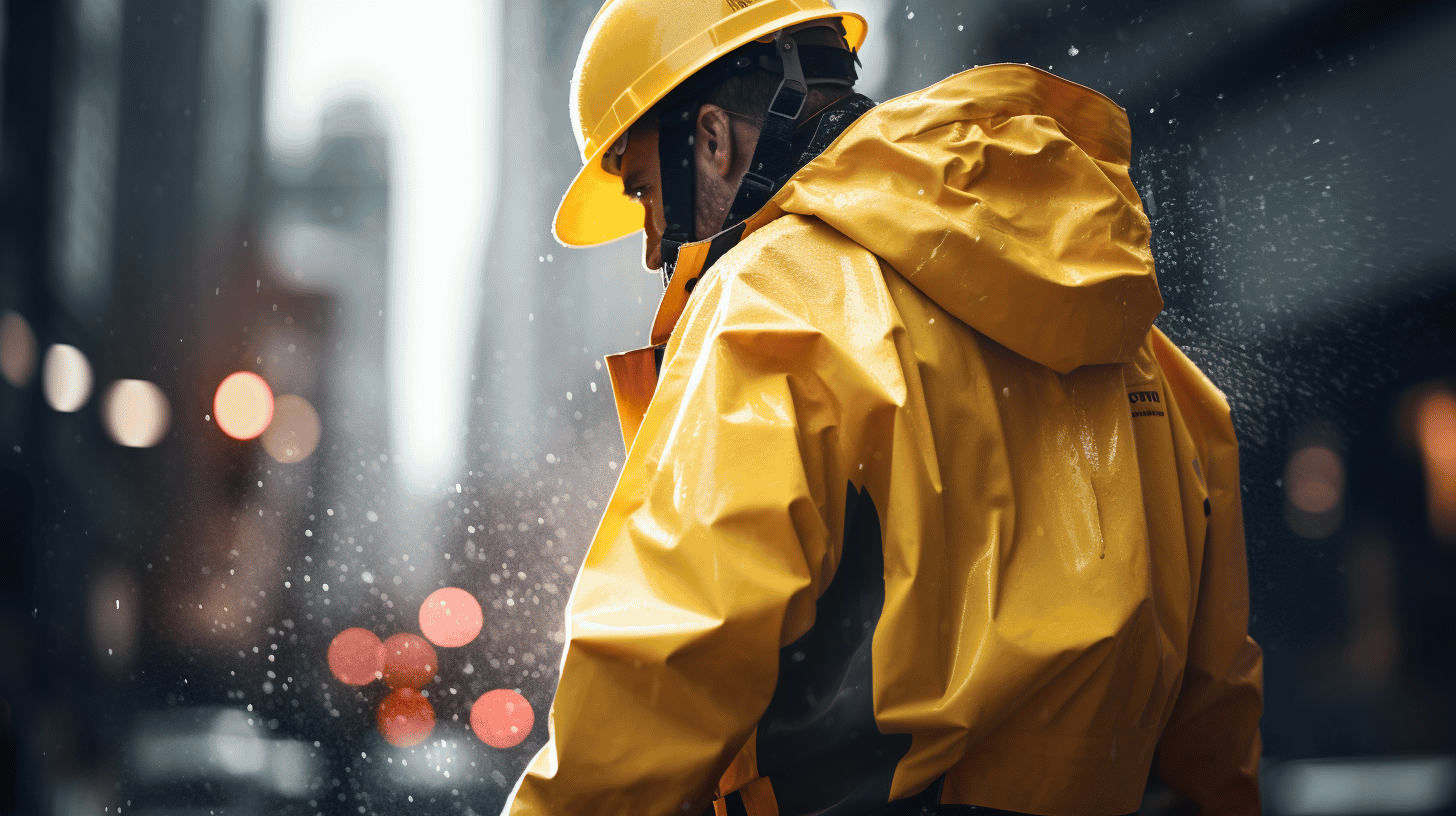Welcome to the future, dear reader, where unpredictable weather patterns are the norm and the construction industry is not left unscathed. We're all too familiar with how a sudden downpour can throw work schedules into disarray, not to mention the physical discomfort and safety risks that wet conditions pose to construction workers. As we look forward to 2024, it becomes more crucial than ever for construction workers to gear up aptly to face the rain head-on, helping them to stay dry, safe, and productive. This article aims to be your comprehensive guide to rain gear for construction workers in 2024, covering everything from anticipating weather changes, understanding the importance of suitable rain gear to choosing the gear that best suits your needs, and even exploring the latest innovations in rain gear technology. With the right information at your fingertips, making weathered decisions will be as easy as putting on a hat!
Anticipating Weather Changes in 2024
When it comes to planning our lives around the weather, having a solid understanding of the forecast is critical. From knowing when to bring an umbrella for an unpredictable spring shower to preparing for an intense heatwave during the summer, these predictions play a significant role in our daily activities. So, as we look ahead to 2024, what can we expect in terms of weather changes? Let's delve into the impending forecasts as well as the impact of climate change.
Weather Forecasts
Firstly, it's important to comprehend the methodology behind weather forecasting. By monitoring atmospheric conditions and applying scientific principles, meteorologists can predict weather patterns and phenomena with remarkable accuracy. State-of-the-art technology, such as satellites and radars, aid this process, making it easier to track storms and identify patterns. Heading into 2024, here's what the weather forecasts are tentatively signalling:
- Increased Rainfall: Climatologists anticipate a rise in precipitation levels across the globe, especially in tropical and sub-tropical regions. This is largely due to warmer atmospheric temperatures, which can hold more water vapour.
- Hotter Summers: In areas that typically experience warm climates, temperatures are expected to reach new highs.
- Harsher Winters: Conversely, regions known for colder climates may experience more severe winter conditions, with more snowfall and lower temperatures than usual.
While these are projections, the actual weather could deviate due to unforeseen atmospheric changes and other factors.
Impact of Climate Change
The elephant in the room when discussing future weather patterns is indisputably climate change. As greenhouse gases continue to fill our atmosphere, they trap heat and subsequently alter weather patterns. Here's how climate change may directly affect the weather in 2024:
- Higher Intensity Storms: Increased sea surface temperatures may lead to stronger hurricanes and typhoons. More heat energy in the oceans fuels these storms, making them potentially more destructive.
- More Heatwaves and Droughts: Climate change might provoke more frequent and protracted periods of high heat and dryness. In areas already grappling with water scarcity, this could exacerbate the problem.
In the looking glass of what 2024 might hold, it's clear that weather patterns are expected to shift, largely influenced by our changing climate. Staying informed about these forecasts not only helps us stay one step ahead for daily planning but also emphasizes the gravity of climate change and our role in addressing it. The future might hold new challenges for us, but with knowledge comes the power to adapt, prepare, and navigate these weather changes. After all, weather is not just about rain or shine. It's about how we appropriately react, adapt, and survive in our ever-changing world.
Importance of Appropriate Rain Gear for Construction Workers
Working in the construction industry means exposure to various environmental conditions – and rain is no exception. An unpredictable and often unavoidable natural element, rain can present multiple challenges for construction workers, making it significant to invest in appropriate rain gear. Having suitable waterproof attire not only offers protection from the elements, but it can also contribute to enhanced productivity and a decrease in work-related injuries.
Protection from Elements
Firstly, the bread and butter of a high-functioning rain gear lie in its ability to protect from the elements. During wet weather conditions, construction workers face environmental obstacles that can hinder their performance and even put their health at risk. Appropriate rain gear addresses these concerns with its water-resistant properties, ensuring that workers remain dry during stormy conditions.
A quality rain garment generally features:
- A water-resistant outer layer: This layer provides the primary defense against exterior wetness.
- Breathable material: Good rain gear should help vent out body heat and moisture, allowing workers to remain comfortable.
- Comfortable fit: A snug yet comfortable piece offers freedom in movement, a key consideration for physically demanding tasks in a construction setting.
Enhanced Productivity
Appropriate rain gear does more than just keeping workers dry; it plays a key role in sustaining productivity levels. Continuous exposure to cold, wet conditions can cause discomfort and exhaustion, potentially stifling a worker's motivation and ability to concentrate on complex tasks. Though a little rain might seem innocuous, prolonged exposure can snowball into serious health issues, including colds and hypothermia. Appropriate rain gear manages to curtail these possibilities, helping to maintain a conducive work environment, and in turn, boost productivity.
Prevention of Work-Related Injuries
Workplace safety is a paramount concern, and in the construction industry, it becomes more crucial due to the inherent risks associated with the job. Wet and slippery surfaces add another layer of hazard, increasing the likelihood of slips and falls. The right rain gear, however, can counter this risk significantly.
With features like non-slip soles and high-visibility colors, it allows workers to traverse treacherous terrains safely while also making them more visible in low light conditions. The addition of sturdy helmets and waterproof gloves can offer further protection, warding off potential injuries.
In sum, the appropriation of correct rain gear in the construction industry can't be understated. It's not a mere accessory, but an integral part of a construction worker's ensemble, facilitating safety, comfort, and productivity, irrespective of the weather conditions.
So, the next time you see construction workers braving the rains, remember it’s their robust rain gear at work, acting as silent, essential armor against the elements.
Rain Gear Essentials for Construction Workers in 2024
Rain gear is crucial in the construction industry since workers often work outdoors, making them exposed to different weather conditions, including downpours, all year round. Preparing for the weather when working in the construction industry goes beyond a convenience—it is a safety must. Here are some of the Rain Gear Essentials for Construction Workers in 2024 that would help enhance productivity, even under wet conditions.
Waterproof Jackets and Overalls
A waterproof jacket is more than an accessory—it's the first line of defense against harsh weather conditions for construction workers. The 2024 selection of jackets are not just practical but also feature-packed. They come with additional layers for warmth, high visibility strips for safety, and numerous pockets for convenience.
Similarly, waterproof overalls have undergone advancements in recent years. They provide full-body protection and keep the wearer dry in the wettest conditions.
The key factors when choosing jackets and overalls include:
- Breathability
- Durability
- Ease of movement
Slip-Resistant Footwear
Slippery surfaces are a common hazard in construction sites when it's raining. Slip-resistant footwear helps in mitigating this risk. Rubber boots, especially ones with deep tread patterns, provide an excellent grip on wet surfaces.
Along with being slip-resistant, good construction footwear in 2024 also includes aspects like:
- Toe protection
- Ankle support
- Electrical resistance
Waterproof Gloves
Waterproof gloves are crucial to keeping workers' hands dry, providing them a better grip on tools. Additionally, they maintain the warmth and comfort of the hands even in wet and cold weather, thereby reducing the risk of any hand-related injuries.
Hard Hat Rain Covers
A hard hat is an indispensable safety gear on construction sites. When it rains, a hard hat rain cover becomes essential. It prevents water from trickling down the face or the back of the neck, keeping the worker dry and comfortable. Some top-of-the-range hard hat covers also come with built-in ear and neck protection.
Tool Bag Covers
Tools are a valuable investment for every construction worker, and protecting them from the elements is necessary. A waterproof tool bag cover can help keep equipment in good condition even during a downpour.
In 2024, workers are favorably considering these rain gear essentials. Good rain gear allows them to work through adverse weather conditions safely and efficiently. It's important to note that rain gear is just a part of the Safety Regulations and Operations in Construction.
These gears significantly enhance comfort, functionality, and safety on rainy days, thereby promoting productivity even in adverse weather conditions.
Considerations When Selecting Rain Gear
Selecting the perfect rain gear may seem like a simple task, but a whole world of choices awaits you. There's no one-size-fits-all rain gear - whether you're a hiker braving the wilderness or a city dweller dodging showers, different variables demand different responses. We've assembled some key considerations to assist in your rain gear shopping.
Material Durability
The durability of your rain gear is no small matter. Be it an unexpected rainstorm while hiking or sudden showers during your commute, your gear needs to withstand the nature’s temper tantrums.
- Nylon and Polyester: Nylon and polyester are popular choices, prized for their strength and lightweight feel. They're both abrasion-resistant, adding to the gear's longevity.
- Polyurethane (PU) Coated Fabrics: Rain gear made from PU-coated fabrics are highly water-resistant. They’re durable and ideal for heavy rainfall.
But remember, durability isn't just about the material. Construction quality, from the seams to the hardware to the zippers, can make or break your gear's lifespan.
Comfort Level
There’s nothing worse than being soaked to the bone in uncomfortable rain gear.
- Breathability: Seek rain gear with a high breathability score. It prevents you from turning into a personal sauna within your raincoat.
- Layering: Think about the gear's ability to layer. Does your jacket allow room for a sweater or a lightweight summer tee?
Remember to think not just about keeping the rain out, but keeping yourself comfortable within.
Level of Waterproof Protection
Every rain gear offers a certain level of waterproof protection, but it's important to match these capabilities with your needs.
- Hydrostatic Head: This is a measure of how water-resistant your material is - a higher hydrostatic head measurement means better water protection.
Remember, 'water-resistant' isn't the same as 'waterproof.' Make sure you know how much rain your gear can truly handle.
Ease of Movement
Your rain gear shouldn’t restrict your movements. It should be designed in a way that allows you to enjoy the great outdoors, or sprint to catch a bus, without feeling encumbered.
- Flexible Material: Focus on gear made from flexible material that doesn't restrict movement.
You should be able to move comfortably in your gear - explore with ease!
Gear Maintenance
Once you've picked your perfect rain gear, look for ways to prolong its life and maintain its quality.
- Washing: Some jackets need special care when washing to maintain their waterproof qualities. Be sure to read your garment care labels!
- Reproofing: Over time, rain gear can lose its waterproofness. Regular reproofing can protect your gear and extend its life.
Now, armed with this guide, your journey in selecting appropriate rain gear should become an easier trek. Choose wisely and keep yourself dry and comfortable, regardless of what the weather throws at you!
Latest Innovations in Rain Gear Technology for 2024
As torrential downpours become more frequent due to climate changes, the demand for rain gear with innovative technologies has skyrocketed in recent years. The year 2024 promises not to be left behind on this wave of innovation. Leading manufacturers are stepping up to the plate, offering advanced materials, breathability enhancements, and smart technology integrations that transcend the traditional concept of rain protection.
Among the most groundbreaking developments is the higher water-resistance proficiency enhanced with Nanotechnology. Essentially, the water-repellent properties are significantly improved by infusing outerwear fabrics with nanoparticles. This results in rain gear that is not only effective at keeping you dry but is also incredibly lightweight.
Take a look at the leading emerging trends:
- Integration of Smart Technology: Rain gear is becoming a lot more than just a barrier against the rain. The integration of smart technology into rain gear, such as sensors to monitor weather conditions and body sensors to regulate body temperature, will be common in 2024.
- Breathability enhancements: No longer will you have to worry about excessive sweating in your raincoat. Advancements in fabric technology offer enhanced breathability, adjusting to body temperature and releasing extra heat when needed, providing optimal comfort.
- Advanced material usage: The use of new materials like the introduction of recycled plastics in fabric production is not only eco-friendly but also improves durability and effectiveness.
"Rain gear in 2024 isn't just about staying dry; it's about staying comfortable, connected, and contributing to a better future."
These developments are just the tip of the iceberg. Numerous other innovative technologies are in the pipeline for inclusion in 2024 rain gear, promising not only effective protection against rain but a vastly improved user experience.
In this journey towards innovation and sustainability, manufacturers are making conscious decisions to contribute to a greener future. Reducing carbon footprint through advanced material production and advocating for a circular economy stands testament to the fact. The future of rain gear technology is here. And it's exhilarating. The year 2024 believes in breaching the frontiers to redefine the paradigms of rain gear technology!
Conclusion
Navigating through inclement weather, especially heavy rains, can indeed be a challenge for construction workers. With the predicted changes in weather patterns and the heightened possibility of more rain-filled days in 2024, investing in top-tier rain gear becomes a necessity, not a choice.
From waterproof jackets and overalls to slip-resistant footwear, hard hat covers, and even tool bag covers, every piece of rain gear plays a crucial role in ensuring worker safety and productivity. However, the selection of rain gear is not all about functionality. Considering aspects such as material durability, comfort level, ease of movement and maintenance are also vital.
Construction companies and workers should rightfully place an emphasis on acquiring rain gear that can withstand the tests of time and nature. And, that’s where Hurricane Raingear comes in. Trusted by thousands of satisfied customers, our 100% waterproof, breathable, and tear-resistant rain gear offers the ultimate protection you seek. Crafted in the heart of the Pacific North West with 100% North-American-Made materials, our gear is designed for unrestricted movement even while offering comfort and robustness. So prep for 2024's weather challenges with the right gear, from Hurricane Raingear.
Frequently Asked Questions
-
What are the best rain gear options for construction workers in 2024?
The best rain gear options for construction workers in 2024 include waterproof jackets, pants, and boots made from durable materials like PVC or Gore-Tex. Additionally, investing in waterproof gloves, hats, and protective eyewear is recommended.
-
Why is it important for construction workers to have proper rain gear?
Proper rain gear is crucial for construction workers as it helps protect them from wet weather conditions, prevents water penetration, and keeps them dry. It also helps maintain comfort, reduces the risk of hypothermia, and enhances safety on the job site.
-
What features should I look for when choosing rain gear for construction work?
When choosing rain gear for construction work, consider features such as waterproof and breathable materials, reinforced seams, adjustable cuffs and hems, multiple pockets for storage, hi-vis or reflective elements for visibility, and compatibility with other safety gear.
-
How do I maintain and clean my rain gear for long-lasting use?
To maintain and clean your rain gear for long-lasting use, follow the manufacturer's instructions. Generally, it is recommended to hand wash or use a gentle machine wash with mild detergent, avoid bleach or fabric softeners, and hang dry or tumble dry on low heat.
-
Can I use regular rain gear for construction work or do I need specialized gear?
While regular rain gear may offer some level of protection, it's advisable to invest in specialized rain gear designed specifically for construction work. These gears usually have additional features like reinforced knees, reflective elements, and extra durability to withstand the demands of the job.























Leave a comment
This site is protected by hCaptcha and the hCaptcha Privacy Policy and Terms of Service apply.